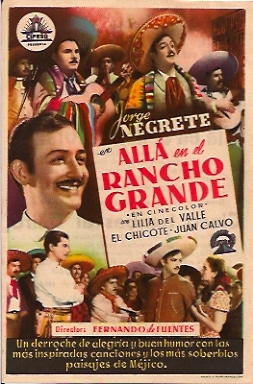A brief overview on Mexican cinema
The first major motion picture shown in North America was in Mexico City in 1896. From then on, the world would be ablaze in a new era of culture, innovation, and energy.
Movies and short film reels would be viewed in cinemas, which spread like wild fire across the United States due to the popularity of these new “moving pictures.” The Hollywood industry would later expand significantly after the introduction of sound in films, following the critical acclaim and praise from the Jazz Singer in 1927.
During the early years of the twentieth century, the Mexican people began to appreciate the film industry that was happening to their north, and prompted the expansion of the Mexican cinema. Even though it was never up to the same standards as Hollywood, Mexican cinema was greatly influenced by the giant American movie companies, by encouraging Mexican directors to document historical events and produce short cultural entertainment through the modern moving pictures.
Many of the first shorts to appear in public in America were new “moving pictures” of real-life events. The Hurricane of 1900 in Galveston, Texas is an example of this, as movie producers filmed the aftermath of this catastrophic event that left the Texas coast homeless and devastated in the wake of utter destruction.
The Wright Brothers added footage of their first airplane flight, President Teddy Roosevelt was filmed a couple of times touring the country, and everyday life in 1910 America was recorded and shown in theatres.
Short pictures were also filmed abroad, capturing the events happening outside of national boarders, such as the inaugural voyage of HMS Titanic and the chaos of World War I.
These reels were soon shown in Mexico, which inspired many to pick up cameras and record the events that were happening around them at that time. The Mexican Revolution (1910-1920), which split the government and its people into five different factions, became an important focused topic to record, as people all over the world were now able to witness first-hand accounts of executions of innocent men, women, and children through the power of these short films.
Using the techniques their American brothers to the north were utilizing, the Mexican cinema quickly grew during and after the revolution, not only allowing more Mexicans to become deeply involved in the history of their country through media, but also spreading the events of Mexico around for the world to witness one of the most grotesque and bloody revolutions of all time.
Not only did the Americans influence the Mexicans to record their past histories for future generations, Hollywood also brought about the start of a cultural wave in Mexico, which would fill movie theater seats to the maximum capacity. Mexican blockbusters began to emerge after the “documentary” phase tired out in the middle of the twentieth century.
While America was spitting out musicals and comedies to entertain their audiences, Mexican directors, such as Gabriel Figuero and Fernando de Fuentes saw that these were the perfect times to produce patriotic and symbolist movies for their audiences down in the south.

Allá en el Rancho Grande (“Out on the Big Ranch”) was one of the first Mexican movies produced in this way; the “Mexican Cinderella” movie included many stereotypes and symbolic Mexican values, such as the “virgin girl” before marriage, the issue of male dominance over women, personal loyalty, and the importance of family and home.
The Mexican cinema continued to grow and flourish; people began wanting more, and the directors gave them finished products, complete with traditional values of Mexico, along with American ties.
Famous Mexican film director, Guillermo del Toro was educated in Hollywood, and using the American film education he received, he became one of the leading figures in the expansion of Mexican media in the country’s culture. His 1993 Mexican film, Cronos went on to win many national and international awards.
In the later years of the twentieth century, Hollywood began to open up their film awards competitions to foreign nations, in particular to Mexico, whom had become a close ally to the United States.
Although Mexico has yet to win, the country has received numerous films nominated for the Academy Award for Best Foreign Language Film.
The heavy American influence on Mexican cinema would forever change the culture of Mexican media, as directors began to follow their northern cousins into the film business and take advice from Hollywood back to their home nation, where movies would spill out in theaters at a consistent rate for the ever-growing movie-hungry public.
Over the past eight decades, Mexican cinema popularity has increased, along with a significant transformation in the culture of Mexico.
Values and symbolism have become major parts of Mexican cinema, as the people are grown to the idea of patriotism. History has been recorded and can be witnessed, thanks to the many Mexican producers whom took films of historical events, similar to what their American partners did.
In making these short film reels, the Mexican cinema would continue to grow and flourish, even in difficult times, such as the revolution.
In the modern day, the country has not only received international recognition at film festivals and award ceremonies, but has also stepped outside of its traditional comfort zone and into the spotlight of the new media, following in the footsteps of their brotherly-neighbors to the north and the American culture on screens.
Published or Updated on: January 26, 2016
